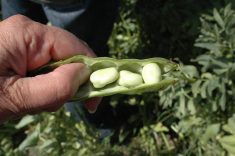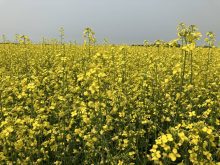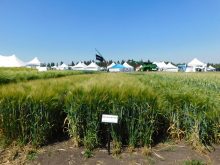Even though May and June were extremely dry months for most of Alberta, rain in July was welcomed and rain in August is possible and perhaps even likely.
“Although precipitation is always welcome during the growing season, these relatively late rains can bring on second-crop growth as well as late flushes of weeds, both of which can lead to challenges at harvest,” says Doon Pauly, crop specialist with Alberta Agriculture and Rural Development, Stettler. “This is the situation that happened in 2002 and could be the scenario again this year. There is value in remembering lessons learned from 2002 because this knowledge can probably be applied this fall.
Read Also

New crop insurer policy enables easier startup for faba beans
Agriculture Financial Services Corporation updated its normals for faba beans, which may open the door for more Canadian producers to feel comfortable growing the pulse crop in the future.
“When early-season drought produces a short, thin stand, there is a real temptation to hope that lush regrowth will compensate for the initial crop and still produce a reasonable grain harvest. This hope may not be realistic, but it was a common assumption and mistake that many producers made in 2002. Realistically, July or August second growth will not make a harvestable grain crop and these fields may be best utilized as grazing, green feed, or silage, rather than grain.”
When deciding what to do with a crop with considerable regrowth, consider what stage the crop and regrowth are at, the heat requirements needed to make it to maturity, and the normal temperatures for the remainder of the growing season. If the estimated heat requirement to reach maturity is above-normal heat accumulation for the area, then it is probably best to make plans to salvage this crop as something other than grain.
Using Growing Degree Days to Predict Plant Stages by Perry Miller (http://msuextension.org/publications/AgandNaturalResources/ MT200103AG.pdf) and Environment Canada’s climate normals and averages for the nearest weather station are excellent resources to help with this decision. If help is needed when using these tools, contact a local agronomist or one of the crop specialists at the Ag-Info Centre (310-3276).
SWATHING DIFFICULT
“When a crop with second growth and late weed flushes is kept for grain, harvest management can be challenging,” says Pauly. “Normally this green growth at harvest can be managed with swathing or chemical dry down (preharvest glyphosate or desiccation with Reglone), but these options are not always possible. Crops that were drought stressed early are often very short and swathing may not be a realistic alternative. Regrowth of weeds and crop into swaths is also likely and another potential limitation with swathing.
“Chemical dry down is not an option in all situations and cannot totally replace swathing. Glyphosate is ineffective on glyphosate-tolerant canola as a crop, or on glyphosatetolerant canola weed growth. Also, glyphosate is not recommended on crops intended as seed for the following year. Reglone is registered for use on many crops, but this does not include wheat or barley. Also keep in mind that both glyphosate and Reglone work best as crop dry-down tools when they are sprayed in warmer, summer-like conditions, and are slow acting or less effective when used in the cool conditions typical of mid-to late September.”
Rain is almost always welcomed during the growing season. Lateseason weed flushes and second-crop growth are some of the effects of rain that can create some harvest management challenges, especially when crops were drought stressed early in the growing season. Producers can manage these challenges by making informed decisions about the suitability of affected crops as either grain or as forage, and by carefully planning out their harvest strategies.
To discuss harvest management strategies in greater detail, contact a crop specialist at the Alberta Ag-Info Centre, 310-FARM (3276) toll free in Alberta.














